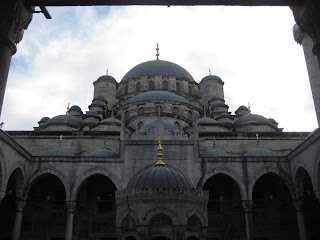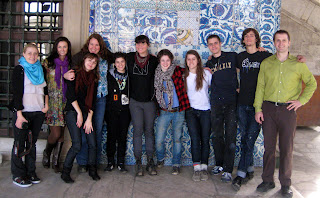Many large mosques are in the heart of mercantile areas. While the Spice Bazaar was built to serve the New Mosque, it is often the other way around, with a mosque being built to serve the people who work and shop in the bazaars. Considering believers need to stop to pray five times a day, it does make sense that places of worship would be close to the most active areas of the city.
Even when very grand, there is a feeling here that mosques are part of everyday life. Certainly the short, frequent visits from the faithful throughout the day account for this, but another reason seems to be in the nature of the domed-architecture itself. Cascading from the large central dome at the peak, the smaller domes multiply and diminish until they finally reach the outer walls. While this architectural form was certainly borrowed from Byzantine architecture, it seems to be exaggerated and refined with later mosques that followed the Byzantine pattern. The result is a lower-at-the-edges design that is more welcoming-looking than the austere Byzantine basilicas on which they are based.
More approachable than most Christian cathedrals, large mosques tend to spill out into the community, with multiple entrances and stone staircases that spread out at the ground plane, rooting the building. The entrances to large-scale mosques are in stages, with stairs from the street leading to large, open courtyards. These usually house an ablution fountain for the ritual washing done before entering a mosque. Again, this architectural pattern adds an earthy, human quality to the main entrance.
The ablution fountains are usually only for show, with the real washing happening at taps on the sidewalls of mosques. At the New Mosque, however, we often see followers washing their hands and feet at the beautiful central fountain. The courtyard itself is grand, surrounded by an arcade and smaller domes, but it feels like a city square, more a meeting place than a sacred space.
The interior of the New Mosque is quieter than most of the historic mosques in the heart of the touristed Sultanahmet district. It isn’t high on the list of guidebook recommendations for Istanbul, mostly because the competition is so stiff. All the better. It is a welcome relief to step out of one of the busiest areas in the whole city and find a little peace under the soaring dome of the New Mosque.
 |
The courtyard and the ablution fountain at the entrance of the New Mosque. |
 |
At the bottom of the central stairs, are half a dozen red booths sell plates of birdseed. |
 |
Looking across the water and the Galata Bridge to the New Mosque |














































